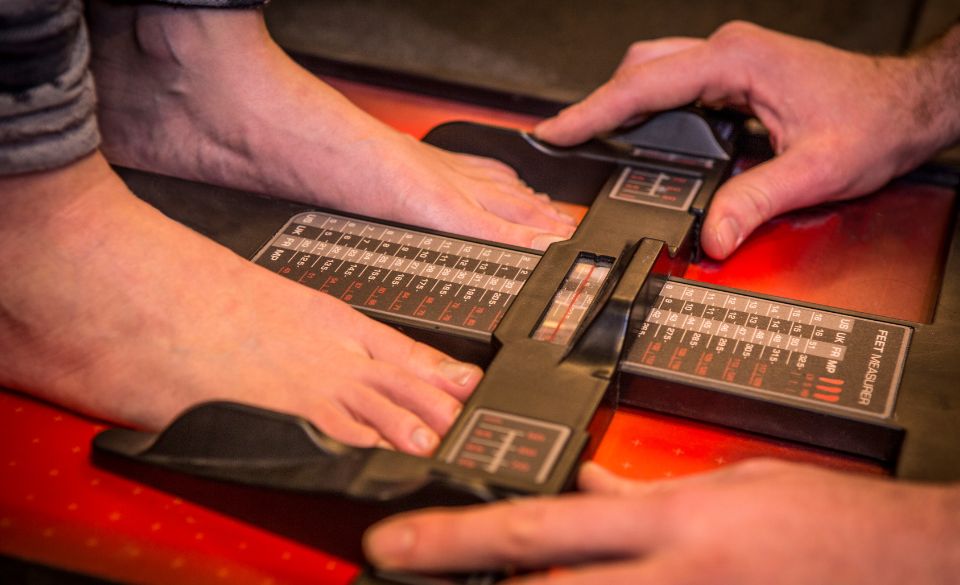
How To Choose The Correct Running Shoe Size
Page Contents
Choosing the right size for your running shoes is crucial for a comfortable and injury-free running experience. Ill-fitting shoes can lead to blisters, discomfort, and even more serious issues like foot and joint pain. Whether you’re a seasoned runner or just starting out, understanding how to measure your feet and select the correct running shoe size is essential. In this article, we’ll guide you through the process of finding the perfect fit for your feet, ensuring that every stride you take is supported and comfortable.
How Do You Measure Feet?
Before diving into the world of running shoe sizes, it’s important to know how to measure your feet accurately. Here’s a simple step-by-step guide to help you get started:
1. Grab a piece of paper, a pen, and a measuring tape or ruler.
2. Stand barefoot on the paper, ensuring that your weight is evenly distributed.
3. Trace the outline of your foot by holding the pen perpendicular to the paper.
4. Measure the distance from the heel to the longest toe point using the measuring tape or ruler.
5. Repeat the process for your other foot, as it’s common for feet to have slightly different sizes.
6. Note down the measurements in centimeters or inches, depending on your preference.
Remember to measure your feet in the evening as they tend to swell throughout the day. This ensures that you choose a shoe size that accommodates any potential swelling during your runs.
How To Choose Running Shoe Size
Now that you have your foot measurements, it’s time to find the right running shoe size. Keep in mind that sizes can vary between different shoe brands, so it’s important to consult the specific brand’s size chart before making a purchase. Here are a few tips to help you select the right size:
1. Compare your foot measurements with the brand’s size chart: Different shoe brands often have their own size charts, so be sure to check the one specific to the brand you’re interested in. Compare your foot length to the corresponding size in the chart to find your starting point.
2. Consider your foot width: Shoe sizes are not only determined by length but also by width. Some brands offer various width options, such as narrow, standard, and wide. If you have wider or narrower feet, you may need to consider selecting a different width to ensure a proper fit.
3. Try on shoes in the afternoon or evening: As mentioned earlier, our feet tend to swell throughout the day. By trying on shoes in the afternoon or evening, you can ensure that you choose a size that accommodates any swelling, preventing discomfort during your runs.
4. Test the fit: When trying on running shoes, make sure there is enough space in the toe box for your toes to wiggle comfortably. Your heel should fit snugly but not be overly tight or slip out while running. Walk or jog around the store to get a feel for the shoes and ensure they provide adequate support and stability.
Remember, it’s not uncommon to go up or down a half size from your measured foot length to find the most comfortable fit. Everyone’s feet are unique, and finding the perfect running shoe size may require some trial and error.
Why Shoe Size Is Important For Runners
Choosing the correct shoe size is essential for runners due to several reasons. First and foremost, a proper fit ensures optimal comfort during your runs. Running in shoes that are too small can lead to cramped toes, blisters, and even black toenails. On the other hand, shoes that are too big can cause your feet to slide around inside, resulting in friction and potential blisters. By wearing the right size, you can minimize these discomforts and focus on your performance.
Additionally, shoe size plays a crucial role in providing adequate support and stability. Running shoes are designed with specific cushioning, arch support, and shock absorption features to protect your feet and joints from the impact of running. When the shoe size is too small, these supportive features may not align correctly with your feet, compromising their effectiveness. Conversely, shoes that are too big can result in instability and a lack of proper foot alignment, increasing the risk of injury.
What Happens If You Buy Shoes That Are Too Small
Opting for running shoes that are too small can have detrimental effects on your running experience. When your shoes are too tight, they can cause excessive pressure on your toes and forefoot, leading to painful blisters and calluses. Tight shoes can also restrict proper blood circulation, causing discomfort and potential numbness during longer runs.
Moreover, wearing shoes that are too small may result in a condition known as runner’s toe, where your toenails repeatedly impact the front of the shoe, leading to bruising or even the loss of a toenail. Additionally, the lack of sufficient space for your feet to expand and swell during exercise can result in foot and joint pain, hindering your performance and recovery.
What Happens If You Buy Shoes That Are Too Big
While it may seem tempting to opt for shoes that are slightly larger to allow for growing room, buying shoes that are too big can cause its own set of problems. When your shoes are too big, your feet can slide around inside, leading to friction and blisters. The lack of proper foot-to-shoe contact can result in reduced stability and support, increasing the risk of ankle sprains and other injuries.
Furthermore, wearing shoes that are too big can alter your running gait. You may compensate for the lack of snugness by gripping your toes or adopting an unnatural stride, which can put excessive strain on your feet, ankles, knees, and hips. This misalignment can lead to overuse injuries and long-term damage to your joints and connective tissues.
Final Words
Choosing the right running shoe size is essential for a comfortable and injury-free running experience. By measuring your feet accurately and consulting brand-specific size charts, you can find the perfect fit for your unique feet. Remember to consider both length and width when selecting a shoe size, and don’t forget to test the fit by trying on shoes and assessing comfort, support, and stability.
Avoid the pitfalls of shoes that are too small or too big. Shoes that are too small can cause discomfort, blisters, and foot pain, while shoes that are too big can lead to instability, blisters, and altered running mechanics. By investing time in finding the right size, you’ll ensure that your running shoes provide the necessary support, protection, and comfort for every stride you take. So lace up those shoes, hit the road, and enjoy your runs with confidence and comfort!



